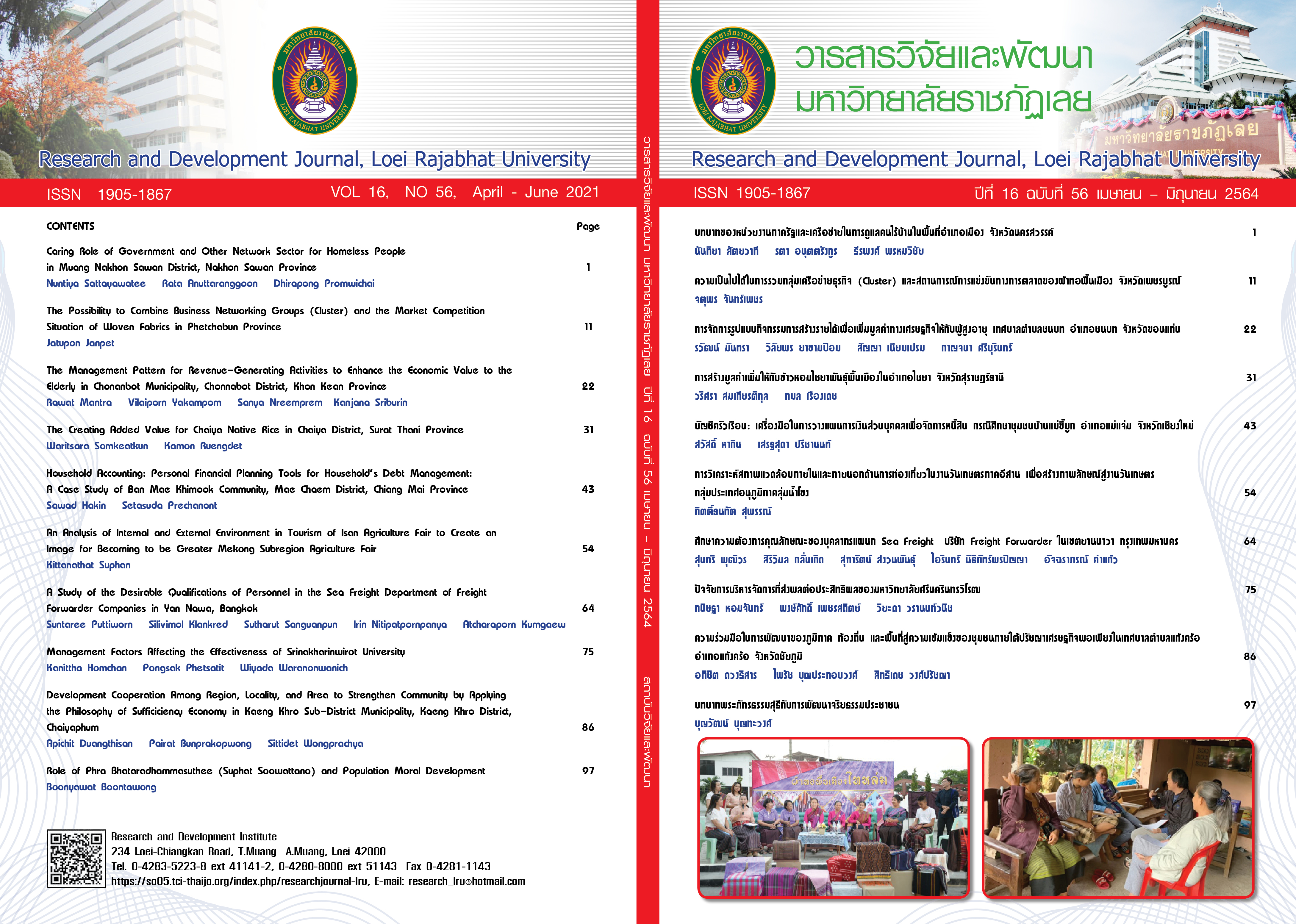การสร้างมูลค่าเพิ่มให้กับข้าวหอมไชยาพันธุ์พื้นเมืองในอำเภอไชยา จังหวัดสุราษฎร์ธานี
คำสำคัญ:
ข้าวหอมไชยาพันธุ์พื้นเมือง, การสร้างมูลค่าเพิ่ม, อำเภอไชยา, จังหวัดสุราษฎร์ธานีบทคัดย่อ
การศึกษาการสร้างมูลค่าเพิ่มให้กับข้าวหอมไชยาพันธุ์พื้นเมืองในอำเภอไชยา จังหวัดสุราษฎร์ธานี มีวัตถุประสงค์เพื่อศึกษารูปแบบการสร้างมูลค่าเพิ่มให้กับข้าวหอมไชยาพันธุ์พื้นเมือง และเสนอแนวทางการสร้างมูลค่าเพิ่ม โดยมีกลุ่มเป้าหมายคือ ผู้ซื้อข้าวสารในจังหวัดสุราษฎร์ธานี จำนวน 400 ราย โดยใช้แบบสอบถาม และการสัมภาษณ์ในการเก็บข้อมูล และใช้สถิติเชิงพรรณนาและสถิติเชิงอนุมานในการวิเคราะห์และสังเคราะห์ข้อมูล
ผลการวิจัยพบว่า รูปแบบการสร้างมูลค่าเพิ่มให้กับข้าวหอมไชยาพันธุ์พื้นเมือง ได้แก่ การพัฒนารูปแบบสินค้าให้เป็นที่ต้องการของตลาด การปรับรูปแบบบรรจุภัณฑ์ให้สอดคล้องกับกลุ่มผู้บริโภค และการแปรรูปเป็นผลิตภัณฑ์ต่างๆ สำหรับแนวทางการส่งเสริมการสร้างมูลค่าเพิ่ม ได้แก่ การพัฒนารูปแบบบรรจุภัณฑ์ การแปรรูปสินค้าให้มีความหลากหลาย การเพิ่มช่องทางการจำหน่าย และการประชาสัมพันธ์
เอกสารอ้างอิง
กฤษฎา แก้วแก่นคูณ และคณะ. (2560). การอนุรักษ์พันธุกรรมข้าวพื้นบ้านโดยชุมชน: บทเรียนการอนุรักษ์ในภาคตะวันออกเฉียงเหนือ. แก่นเกษตร, 45(ฉบับพิเศษ 1). 1528-1533.
ชัยณรงค์ ทรายคํา. (2552). ปัจจัยที่มีอิทธิพลต่อการตัดสินใจซื้อรถยนต์ส่วนบุคคลของผู้บริโภคในจังหวัดลำพูน (วิทยานิพนธ์ปริญญามหาบัณฑิต). มหาวิทยาลัยเชียงใหม่, เชียงใหม่.
ชัยฤทธิ์ ดำรงเกียรติ. (2555). เตรียมดันข่าวหอมไชยาให้เป็นข้าวจีไอ ที่มีคุณสมบัติทางโภชนาการที่โดดเด่น.ข่าวภาคใต้. สืบค้นจาก mgronline.com›ภาคใต้›ข่าวภาคใต้
ทศธรรม สิงคาลวณิช. (2553). รูปแบบการสร้างมูลค่าเพิ่มในอาคารชุดพักอาศัยระดับกลางบนถึงระดับบนในเขตวัฒนา-คลองเตย กรุงเทพมหานคร (วิทยานิพนธ์ปริญญามหาบัณฑิต). มหาวิทยาลัยธรรมศาสตร์, กรุงเทพฯ.
สำนักงานเกษตรอำเภอไชยา. (2561, 25 สิงหาคม). ข้อมูลการขึ้นทะเบียนเกษตรกรผู้ปลูกข้าวพันธุ์ทั่วไป. สืบค้นจาก https://chaiya.suratthani.doae.go.th
อรวรรณ ศรีโสมพันธ์. (2556, 27 สิงหาคม). โครงสร้างการผลิตและการตลาดข้าวหอมมะลิไทย. สืบค้นจาก https://elibrary.trf.or.th
Chematory, L., Harris, F., & Dall’Olmo Riley, F. (2000). Added Value: Its nature, Role and Sustainability. European Journal of Marketing, 34(1-2), 39-56. http://dx.doi.org/10.1108/03090560010306197
Kotler, P., Wong V., Saunders J., & Armstrong G. (2005). Principles of Marketing. (4thed) England: Pearson Educations Limited.
Levitt, T. (1980). Marketing Success through Differentiation of anything. Harvard Business Review, 1(2), 83-91.
Naumann, E. (1995). Creating Customer Value. The Part to Sustainable Competitive Advantage, Thompson Executive Press, OH.
Nilson, H. T. (1992). Value-Added Marketing. Marketing Management for Superior Results. London: McGraw-Hill.
Ravald, A. & Grönroos, C. (1996). The Value Concept and Relationship Marketing. European Journal of Marketing, 30, 19-30. http://dx.doi.org/10.1108/03090569610106626
Yamane, Taro. (1976). Statistics: An introductory analysis (2nd ed.). New York: Harper and Row.
Walters, C. Glenn. (1987). Consumer Behavior: Theory and Practice 3 rd. ed. (Homewood, Illinois: Richard D. Irwin, Inc, 69.
ดาวน์โหลด
เผยแพร่แล้ว
รูปแบบการอ้างอิง
ฉบับ
ประเภทบทความ
สัญญาอนุญาต
ข้อความที่ปรากฎในวารสารฉบับนี้เป็นความคิดเห็นของผู้เขียนแต่ละท่าน สถาบันวิจัยและพัฒนา มหาวิทยาลัยราชภัฏเลย และกองบรรณาธิการ ไม่จำเป็นต้องเห็นด้วยและไม่มีส่วนรับผิดชอบใดๆ
สถาบันวิจัยและพัฒนา มหาวิทยาลัยราชภัฏเลย ขอให้ผู้อ่านอ้างอิงในกรณีที่ท่านคัดลอกเนื้อหาบทความในวารสารฉบับนี้






